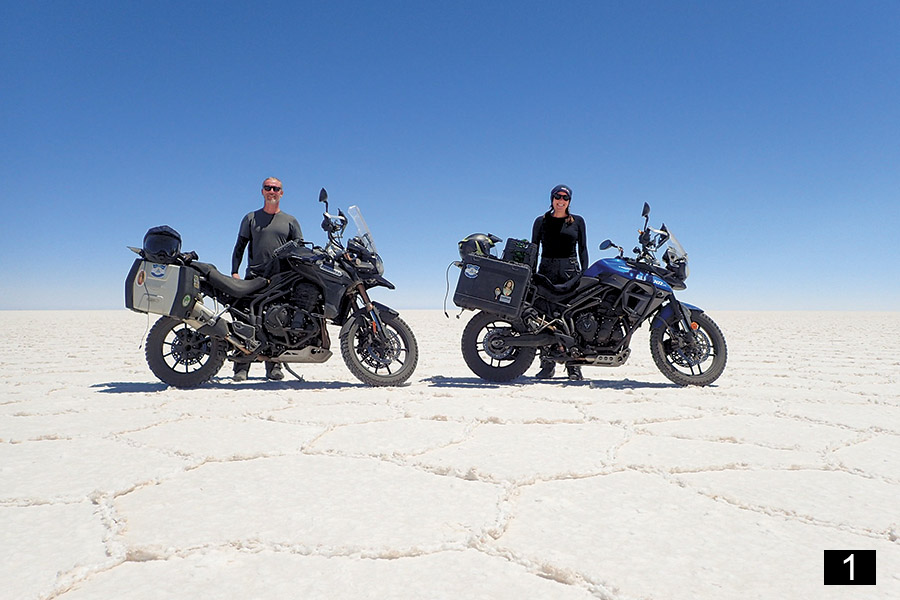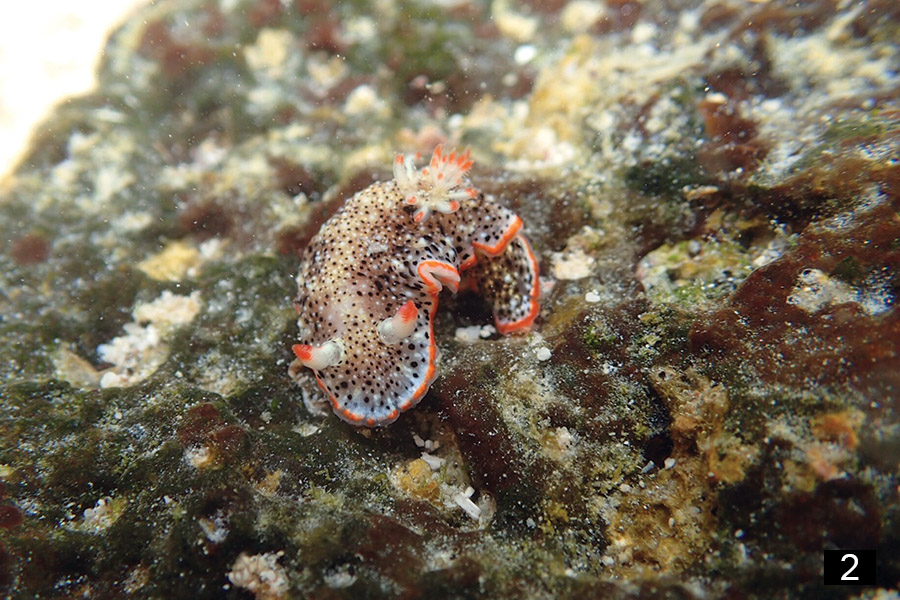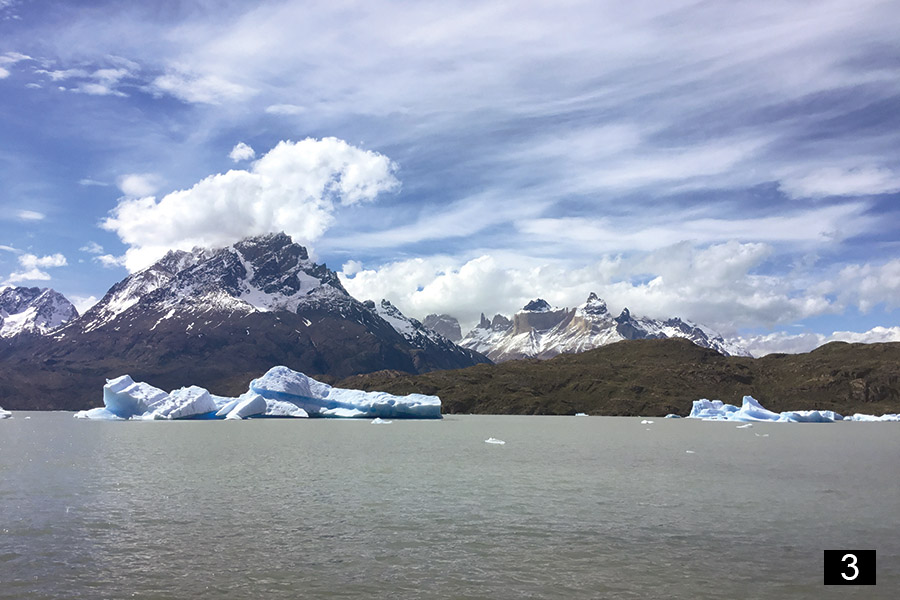
Portland Magazine
Biology
February 21, 2019
Biology and environmental studies professor Tara Prestholdt may have redefined the word “sabbatical.” Did she take the time to write and publish in her field? Yes, she did that. But she also rode her motorcycle from Portland to the southern tip of South America in order to “see, smell, and touch flora and fauna I had only read about in books.” In 138 days, she and her husband, Ernie, went to 14 countries and logged 12,965 miles.
Her academic interests in animal behavior, marine biology, entomology, and evolution were her lens. What follows are excerpts from her blog “Gringos y Pinguinos,” documenting her remarkable and remarkably challenging journey. Many of these observations and stories—including a renewed advocacy for keeping plastic out of our oceans—have already made their way into her lectures here at University of Portland.
We pick up Tara’s journey about a month after she and Ernie left their home in Portland.

Story and photos by Tara Prestholdt
What day is it? Ernie and I really can’t say. We know it’s July 6, but day of the week? We’ve narrowed it down to Wednesday or Thursday. We love having this problem.
By 5 a.m. we headed to the tide pools. My very first sighting was Hemigrapsus nudus, or purple shore crab, which is the species I have studied for the past seven years at UP. Little fella with two regenerated legs. We moved on to the mid-tidal zone, flipped a rock, and found half a dozen brittle stars (huge, the size of a baby’s head), a few sea cucumbers, two flatworms, and three juvenile sunflower stars. These guys and gals got a move on! (In Oregon, there wouldn’t have been as many, and they would have been motionless.) Even the sunflower stars were speedy.
By 8 a.m. it was hot and humid enough to cause anger, so we packed up as quickly as possible.
This morning we got a visit from a very large scorpion— beautiful lime green color. It was probably 6" long (if one were crazy enough to elongate it). Despite the heat, I was all of a sudden ready to trade in my flip-flops for my motorcycle boots.
Exhausted from a 93-mile ride (four hours at about 30 mph while inhaling truck fumes). So much trust is required on this trip: trust in the bikes, trust in our gear, trust in the roads, trust in the people that point and wave and say, “Sí, sígue” (yes, follow). It is hard to trust this much.
The real gem of the place is the ocean pool. It was built with such care and imagination. There was no coral or otherwise colorful substrate, but there was enough algae and plankton to make it a damn fine feeding hole. And luckily, we were there as high tide was coming in, so it was a feeding frenzy. Overall, we give it a low diversity rating but high behavior rating. Two highlights were watching and interacting with the moray eel and the cornetfish. We saw another million sally lightfoot crabs and our first spiny lobster—every color of the rainbow was visible on this little buddy.
I must be happy. I just saw a hermit crab and thought, “Even the hermit crabs are cute here.” (My students know I hate hermit crabs.)
This part of Mexico is a snow globe of mariposas (butterflies).
Lots of gringos feeding the spider monkeys despite all the signs that say don’t feed the monkeys.
Fun fact: the extinct giant sloth was bigger than a mammoth. Someone please invent a time machine.
Another fun fact that if I knew I forgot: before Panama existed, ocean currents came through North and South America. After Panama, water was forced up the North Atlantic. If not for that movement of water (and the effects of that new circulation pattern), there would not have been an ice age. Panama keeps advertising itself as the country that changed the world. Check.
Only an hour after writing about why I don’t like boats, a pod of bottlenose dolphins decided to pay us a visit. I love boats. My hypocrisy knows no bounds.
I got a great bird sighting today—a Moctezuma oropendola. Admittedly, I had no idea what I saw when I saw it, other than an amazing tail. Bright, vibrant yellow with a black stripe and fanned out in such an elaborate way. It had a black/brown body and a splash of color at the head (bill? spot? crest? crown? I didn’t know). Only two birds in the world have a tail like that, and only one lives on this continent, so process of elimination led me to the correct ID. It is another bird I use as a case study in one of my classes.

I had a cry over the visitor’s center. While the information they did have was good, and I am stoked they are taking a major interest in conservation and the future, there was not a single placard or exhibit that explained evolution or natural selection. Not a single bit of educational information on what Darwin contributed to the realm of biology.
It is impossible to say how each tourist is affected by their experiences with animals here. For those who sit and watch, wait and listen, smile and move gently, I can hazard a good guess that they were positively affected by what they experienced. But others mystify me. For example, on Tortuga Bay I watched a young woman take off her cover up and, in her mini bikini, lie down on a branch next to a sea lion. She assumed a pose that was on par with the 2016 Sports Illustrated centerfold. I also saw a very fit and sun-kissed young man take a selfie while flexing in front of an iguana. Why was he flexing? Was he going to punch the iguana? It’s as if these tourists are kids right after they crack open a piñata. They scramble so frantically to collect the sweet moments they don’t even know what they are collecting. As a steward of ethology and evolution, it is hard to see those tourist experiences as respectable because it is really hard to imagine the ecological experience they are taking with them. As Ernie says, there are iguanas here that have more of an internet presence than he does.
The polychaete worm I brushed up against in the Galapagos continues to molest me. (Is it karma or the universe telling me I shouldn’t have tide pooled?) My finger is now very swollen and covered with tiny blisters. It burns, itches, and aches. The finger still fits in my moto gloves, so I don’t have to cut it off yet...
We saw dozens and dozens of dead sea lions rotting on the beaches. Hundreds and hundreds of pinnipeds have washed up over the past three years. I couldn’t find anything definitive, but most of the information says the fishermen are poisoning them. With depleting fish stocks and the pressure the fishermen face, I am saddened but not surprised. (Peru is number three on the list of countries that take the most from the ocean—the top five goes to China, Japan, Peru, Chile, USA.)
I may or may not have cried several times last night and today. I am strong enough to do this trip; I am just not strong enough every minute of every day. I have to work at being strong and patient. This trip is hard. A good hard, but hard. Back home I have my own ways of keeping up my mental and emotional strength for the challenging parts of life. On this trip the things that require me to be strong and patient are quite different. The wind, the fog, the rain, the heat, and the cold. The vulnerability and the not knowing.
My own stench and filth. Getting lost. Eating crappy food. Body pains. I am not inherently peachy keen or okey dokey with these things; I have to work at accepting these things. Yes, I am adventurous and energetic, but I am also a worrier and a planner. I enjoy motorcycling very much. I also enjoy massages and Netflix. Today marks the three-month mark, and I guess these long and tough days in Peru just broke me a bit. It’s a bad head space to be in, and it affected our morale. Northern Peru has left a little crack in me. Very few will ever notice it, but I’ll know it’s there.
Banner day for us. After about another 30 miles of smallscale farms, we went up a bit in elevation, and the farming turned to ranching. Fuzzy and cute cows, woolly sheep with tails, and lots of llamas and alpacas. The mountains in the background of our little valley got steep, dark, and snowcapped. Herds of alpacas and huacayas to our right and Chilean flamingos to our left. Sonrisas (smiles).
About 50 to 70 Bolivians, including women and children, have set up a road block. There are piles and piles of rocks in the road. We asked the people, “¿Por qué?” And they told us it’s because of water, they have no water. We later learned their water tanks weren’t getting filled. They told us we could pass in two days. Until I knew what was going on, I felt inconvenienced and that the whole thing was a disruption to our day. Lo siento (I’m sorry).
Ernesto-MacGyver wired up my heated vest last night. I was a happy, toasty torso all day.

Another glacier melting from global warming had pieces break off two weeks ago, and they floated to the shore where we could see them. The rocks had two layers of patterns. The first formed over millions of years; it takes that long to form the colors and angles and mangling of the strata. The second pattern—called “bricks”—are formed by freeze-thaw water cycles and only take dozens of years to form. Torres del Paine has strata that are a few millimeters thick as well as a few meters thick, so to see all that time in the Earth on so many different scales was astonishing.
Today was the rainiest day of our trip. Outside of about 20 minutes, we had solid rain from start to finish. And it was 45 degrees. I couldn’t feel my feet after about 30 miles, and I was in a state of shivering thermogenesis for the last 62 miles. My hypothesis is that Mother Nature wanted to let us know that she thanks us for taking this trip on a motorcycle (and not in a car where we can’t feel her) and that we have her to thank for the overall amazing weather. Looking back on how some rides could have been under different conditions, we know we experienced very good weather. So to you, Mother, you are welcome and thank you.
Photos: 1) One hundred and two days into the journey, Tara and Ernie stand on Salar de Uyuni, Bolivia, the largest salt flat on Earth (more than 4,000 square miles). the lake Dried up 30-50,000 years ago. 2) This beautiful nudibranch—a Felimida dalli—is two centimeters long. 3) Torres del Paine National Park, Chile.
University of Portland
5000 N. Willamette Blvd.,
Portland, Oregon 97203-5798
503.943.8000
This website uses cookies to track information for analytics purposes. You can view the full University of Portland privacy policy for more information.
